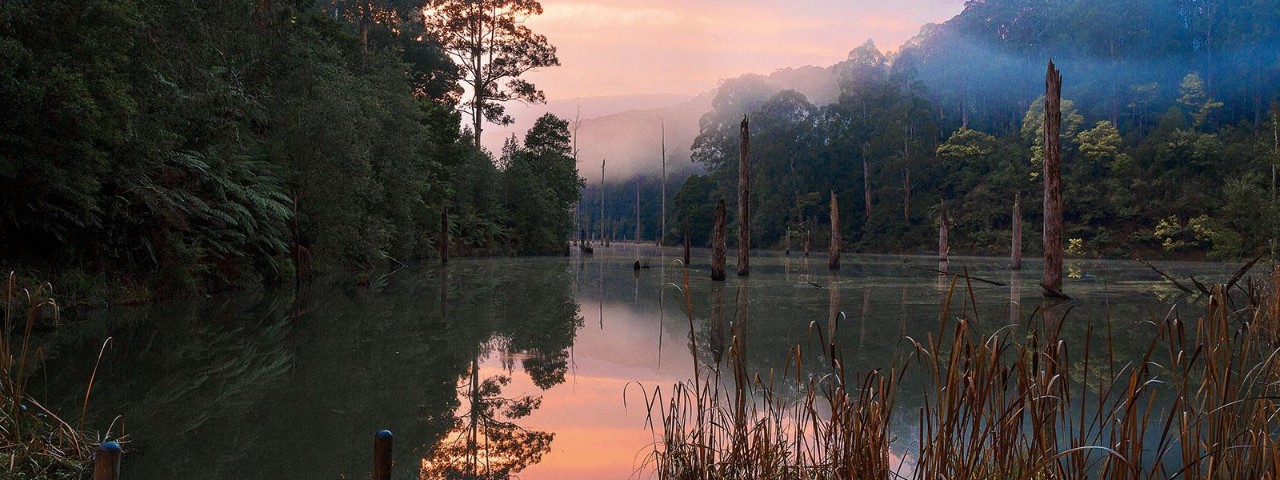The Greater Melbourne area has a rich history ripe for exploration. From the gaols to mansions, here are the best historical experiences in Melbourne to check out.
The birth of Lake Elizabeth

The Otways' Lake Elizabeth is less than a century old, but its beauty and tranquillity are timeless.
Lake Elizabeth is a newborn body of water, birthed by one unseasonably wet year. It rained relentlessly in 1952 in the Otways. But in June the East Barwon River stopped flowing, and a search party was sent upriver to find out what had become of the water.
They found a landslide had come off the valley wall, creating a dam. By August the river had filled the new lake, created a slipway, and was running again. A year later, after more heavy rain, the top 26 metres of the landslide dam wall washed away leaving a lake only one fifth as big as its first incarnation. Thus we have a perched lake so young, its whole lifespan is known.
Being in the Otways, of course, it’s a lovely drive to get to Forrest, especially from the direction of Geelong. West to Winchelsea over hills lined by windbreaks of sugar gum and cypress, then southwest through the hamlets of Deans Marsh and Barwon Downs, both shedding weatherboards and leaning geriatrically, places for retirees and escapees. Various wattles flank the roads on the inland side of the Otways and the traffic is local, unhurried utes transporting cockies and kelpies.
Forrest was a timber town but is now a green place made of the type of gentle tourism that includes scones, history walks, a microbrewery, a guesthouse, wooden cottages and rusting machinery.
A six-kilometre drive from town into the Great Otway National Park, past the West Barwon Reservoir way below (from which Geelong gets its water) and through stands of messmate and into the towering mountain ash forest brings you to a small camping ground of about 20 sites. There are toilets and contained fireplaces, but the camping is for tents only. A solitary camper is enjoying a cup of tea, last night’s wine bottle on the table, all Eden to himself.

It is dawn. The walk to the lake is an easy kilometre alongside the murmuring East Barwon River. On the track I come face-to-face-to-face with a chocolate-coloured swamp wallaby and its joey blinking at me from her pouch.
When the joey decides I’m a shady character and ducks indoors, Mum takes off into the scrub.
Halfway to the lake is a billabong, on which is the perfect reflection of the wall of tree ferns that rises above it on its far side. The lake is around 600 metres long and 100-200 metres wide. This spring morning its surface is patterned with great yellow swirls of pollen. In its tannin-tinted shallows I watch a platypus search for food.
It’s hard to get close to a platypus here, on this open-shored lake, although there are a few canoes in which Bruce, a local, takes platypus-spotting tours. Later, on my walk out, some park workers give me directions to several nearby sites where you could see “thousands … well, not thousands” much closer.
The gunbarrel-straight trunks of the mountain ash that drowned when the lake was formed stand on their reflections in the water. I sit and the birds come. Some are gang-gangs, their call reminiscent of a cork being pulled from a bottle (for those of us old enough to remember that gorgeous sound).
Yellow robins skitter up tree trunks. Coots and various ducks paddle the water, while cattle egrets stand in the shallows. Fantails dance on air and superb wrens bounce through the undergrowth as yellow-tailed black cockatoos rend branches high overhead. There are honeyeaters, a bassian thrush and spotted pardalotes and, in the bulrushes, reed warblers. All these in only minutes.
Then, as if from the primeval past, the territorial call of a koala echoes through the valley. People who haven’t heard a koala call are amazed at the gigantic projection of blunt sound, a series of grunts morphing to a roar that suggests you are being stalked by a silverback. A busload of international tourists might stampede if not forewarned.
The walk to and around the lake is just four kilometres. There is a beach on one side, and a wetland at the far end, where you might stop for a picnic. On the northern shore the track runs beneath towering treeferns and the largest blackwoods I’ve seen. What I don’t see on my walk is other visitors. But in summer there are occasional swimmers, and serious fly fisherfolk catching brown trout, and sham fly fisherfolk catching solitude.
For its ease, brevity and beauty, it’s one of the most naturally rewarding walks in the state. And surely one of the sweetest places to pitch a tent.
Six things to do locally
- Otway Eco Tours boast a 90 per cent chance of seeing platypus on Lake Elizabeth.
- Forrest calls itself Australia’s top mountain bike destination and has 16 bike trails.
- West Barwon Reservoir is one of the state’s best loved fly-fishing locations.
- Forrest Brewing Company makes a variety of year-round and seasonal beers.
- Find these and more at forrestvictoria.com
Get there
- From Forrest follow the signs to Lake Elizabeth. The turn-off is about six kilometres from town. From the car park, it is a difficult walk to the lake, you may need a torch and protective gear.


